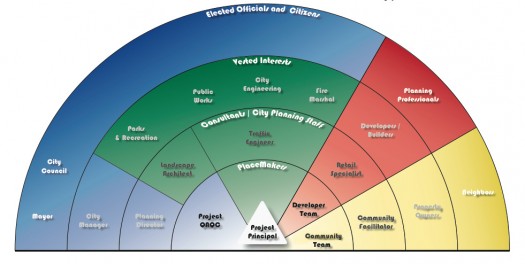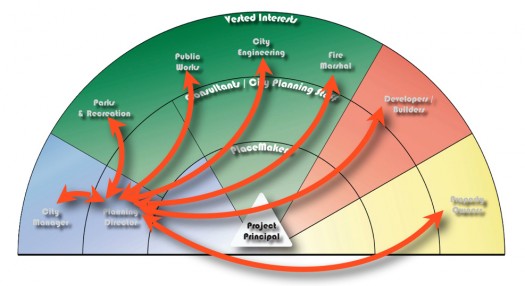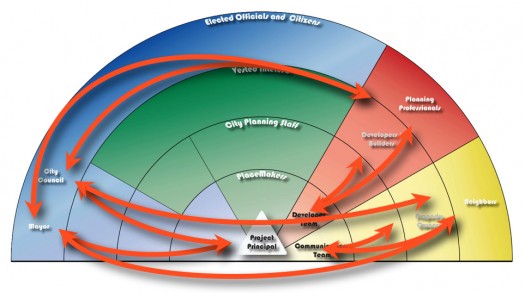A Placemaking Journal
Zoning Reform: Who do you think you’re talking to?

Changing a city or county zoning ordinance is more than just a change in code. It’s a change in paradigm for the development community. It’s a change in options and opportunities. It’s a change to the look and feel of the places everyday people call home.
But more than anything, it’s just change. And that can create a great deal of angst within a community.
The constituencies are varied, with divergent goals, fears, interest in zoning, and ability to understand the document. Yes, your immediate audience is usually the Planning Director, but the development community and landowners tend to have the greatest influence with elected officials and, ultimately, a coding process comes down to a political decision.
As in all things political, you’re navigating people. People who may not be able to picture their objectives in the context of yours. Identifying them is your first step towards building bridges of understanding. This chart lays out the various types of audiences.
Overlap and cross-communication exist between the various audiences. But, while the chart gives the impression that all communication flows out from the center, the patterns are far more fluid and complex.
Internal Audiences
A successful process includes teams with specialties in communications, economic development, development issues, planning, and coding. It begins by addressing communications, which translates the technical language of a coding endeavor into something accessible to the community. Effective communications set the message and create the bridge between the process at hand and the concerns — impacts on economic opportunity, neighborhood character, property values, quality of life, and long-established patterns for “how things are” — of your constituent audiences. These communications efforts tell a coherent story of collective benefit, taken forward by two critical teams: community and development.
The Community Team directs public outreach and engagement, including property owners and neighbors.
The Developer Team speaks the language of economic advantage to engage the audience most resistant to change: those with skin in the game. The development community is often the key audience, not because they rank higher than others but because the ultimate success or failure of a new ordinance depends upon their use of it. That means, again, that they need to be able to clearly see their success in the context of yours.
Communication between the developer audience and the property owner audience can often take the form of a hot debate. After decades of zoning-mandated sprawl, many citizens simply distrust the development community. The whole team may end up serving as a community psychiatrist in facilitating this conversation.
Consultants and City Planning Staff
The Planning Director manages the project for the local government and specialty sub-consultants assist in drafting technical portions of the code. This audience level is fairly straightforward. Most participants engage directly with the Project Principal, and there is little overlap. One exception is the role of the Planning Director as illustrated below.
A Planning Director in support of the effort serves as an advocate and an educator both with other local government divisions, and in community outreach.
Audiences with Vested Interests
These audiences leverage their political relationships to achieve their goals. The development community and community activists usually have strong political relationships, and do not hesitate to use them.
The City Manager may be a great asset to the process, and usually has the ear of the Mayor and City Council. He/she has the authority to redirect recalcitrant staff.
City Department Directors vary from place to place, and frequently are cautious or skeptical about a new ordinance. They all have editorial review of the ordinance, and must be educated and even wooed.
The Developers and Builders have the strongest vested interested in the process and can, for all the reasons mentioned earlier, begin from a defensive posture.
Property Owners also have a large vested interest, but tend to become supportive upon understanding the additional property rights that may come with the new ordinance.
Political Audiences
The adoption of a zoning ordinance is a political decision. So opponents to the process may lobby their elected officials to delay or derail the code. It is critical to engage with the elected officials early and often.
The image above illustrates how messy the external political process can become. Elected officials may feel bombarded by lobbyists, and the Project Principal must do damage control with them while the Community and Developer Teams interact with their constituents to address outstanding concerns.
Accurate audience analysis is crucial to success in adopting new codes — form-based or otherwise. A thorough analysis helps address the needs of each audience and helps the team know how to meet those needs.
Simply put: Know who you’re talking to.
The primary goal of the local government and their consultants is to adopt the code. Satisfying the needs of the various audiences maximizes your prospects for successful implementation.
–Susan Henderson
If PlaceShakers is our soapbox, our Facebook page is where we step down, grab a drink and enjoy a little conversation. Looking for a heads-up on the latest community-building news and perspective from around the web? Click through and “Like” us and we’ll keep you in the loop.











